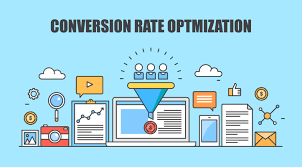In the competitive world of e-commerce, achieving a high conversion rate is crucial for the success of any online store. Conversion rate optimization (CRO) involves improving the percentage of website visitors who complete a desired action, such as making a purchase. Australian experts in e-commerce website development have honed several strategies to boost conversion rates. This article explores these strategies, offering insights and practical tips for optimizing conversion rates on e-commerce websites.
Understanding Conversion Rate Optimization (CRO)
Conversion rate optimization is the process of enhancing a website to increase the number of visitors who take a desired action. This can include purchasing a product, signing up for a newsletter, or filling out a contact form. CRO is essential for maximizing the return on investment (ROI) from your marketing efforts.
The Importance of CRO in E-commerce
In e-commerce, even a slight increase in conversion rate can significantly impact revenue. For example, a 1% increase in conversion rate for an online store generating $50,000 in monthly revenue can add an extra $500 per month, or $6,000 per year, without additional marketing costs. This makes CRO a cost-effective strategy for boosting sales and profitability.
Strategies for Optimizing Conversion Rates
1. User-Centric Design
A user-friendly website design is the foundation of a high conversion rate. Australian e-commerce experts emphasize the importance of intuitive navigation, clear calls to action (CTAs), and a streamlined checkout process.
- Intuitive Navigation: Ensure that your website is easy to navigate. Users should be able to find products quickly and easily. Use clear categories and a robust search function.
- Clear CTAs: Calls to action should be prominent and persuasive. Use action-oriented language like “Buy Now,” “Sign Up,” or “Get Started.”
- Streamlined Checkout Process: Reduce the number of steps required to complete a purchase. Offer guest checkout options and multiple payment methods to minimize friction.
2. Mobile Optimization
With a significant percentage of online shopping occurring on mobile devices, optimizing your e-commerce website for mobile users is essential. According to Statista, mobile e-commerce sales accounted for 54% of total e-commerce sales worldwide in 2021. Australian experts recommend the following:
- Responsive Design: Ensure your website is responsive and adjusts easily to different screen sizes.
- Fast Loading Speed: Mobile users expect quick load times. Optimize images and use content delivery networks (CDNs) to improve loading speeds.
- Easy Navigation: Simplify navigation for mobile users with larger buttons, easy-to-read fonts, and minimalistic design.
3. A/B Testing
A/B testing involves comparing two versions of a webpage to determine which one performs better. This method allows you to make data-driven decisions and optimize your website based on user behavior.
- Test One Element at a Time: Focus on one element, such as headlines, CTAs, or product images, to isolate the impact of changes.
- Use Reliable Tools: Utilize tools like Google Optimize, Optimizely, or VWO to conduct A/B tests and analyze results.
- Analyze Results: Review the data to determine which version performs better and implement the winning variation.
4. Personalization
Personalizing the shopping experience can significantly enhance conversion rates. Tailoring content, product recommendations, and offers to individual users can create a more engaging and relevant experience.
- Behavioral Targeting: Use customer data to personalize product recommendations based on browsing and purchase history.
- Dynamic Content: Display dynamic content, such as personalized banners and pop-ups, to capture user attention.
- Email Marketing: Segment your email list and send personalized offers and product recommendations to different customer groups.
5. High-Quality Product Images and Descriptions
High-quality images and detailed product descriptions can influence purchasing decisions. Australian e-commerce experts recommend the following:
- Multiple Images: Provide multiple high-resolution images from different angles to give customers a comprehensive view of the product.
- Detailed Descriptions: Write detailed product descriptions that highlight key features, benefits, and specifications. Use bullet points for easy readability.
- Customer Reviews: Display customer reviews and ratings to build trust and provide social proof.
6. Trust Signals
Building trust with potential customers is crucial for conversion. Incorporate trust signals throughout your website to reassure visitors.
- Security Badges: Display security badges from trusted providers like Norton, McAfee, or SSL certificates.
- Money-Back Guarantees: Offer money-back guarantees or free returns to reduce the perceived risk of purchasing.
- Customer Testimonials: Showcase customer testimonials and case studies to demonstrate your product’s value and reliability.
7. Effective Use of Analytics
Utilizing analytics tools can provide valuable insights into user behavior and identify areas for improvement. Australian e-commerce experts highlight the importance of:
- Google Analytics: Use Google Analytics to track user behavior, identify high-exit pages, and analyze traffic sources.
- Heatmaps: Implement heatmaps tools like Hotjar or Crazy Egg to visualize user interactions and identify areas of interest.
- Conversion Funnels: Analyze conversion funnels to pinpoint where users drop off and optimize those steps.
Real-World Success Stories
Case Study: Australian Retailer Boosts Conversion by 20%
An Australian online retailer implemented several CRO strategies, including A/B testing, mobile optimization, and personalized recommendations. By streamlining the checkout process and enhancing product pages, they achieved a 20% increase in conversion rates within six months.
Case Study: Small Business Sees 15% Sales Increase
A small Australian e-commerce business focused on improving trust signals and high-quality product images. By displaying security badges and detailed product descriptions, they experienced a 15% increase in sales over three months.
Conclusion
Optimizing conversion rates for e-commerce websites is essential for maximizing revenue and staying competitive. Experts of e-commerce website development in Australia emphasize the importance of user-centric design, mobile optimization, A/B testing, personalization, high-quality product images, trust signals, and effective use of analytics. By implementing these strategies, online retailers can enhance the shopping experience, build trust with customers, and ultimately boost conversion rates.
Incorporating these proven strategies can lead to significant improvements in conversion rates, helping e-commerce businesses achieve their goals and drive growth. For those seeking professional assistance, engaging with experts in conversion rate optimization Australia and e-commerce website development Australia can provide tailored solutions to enhance their online presence and profitability.


